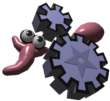Why does the humanoid below simply fall over ?
Originally it seemed to be a center of gravity problem so i made the
feet huge. Now it seems to have something to do with the inability of
the ankles to support the creatures wieght. I am very familiar with
neural nets but being new to framsticks , I am not sure how to fix the
problem.
# created Sun Jun 30 21:28:17 2002
# by Framsticks 2.0 (16 May 2002)
org:
name:stan
genotype:~
//0
p:-.2,.4,0,v=.1
p:-.2,0,0,v=.1
p:.2,.4,0,v=.1
p:.2,0,0,v=.1
p:-.14,.16,.4,v=.1
p:.14,.16,.4,v=.1
p:0,.2,.8,v=.1
p:0,.3,1.2,v=.1
p:-.14,.14,.95,v=.1
p:.14,.14,.95,v=.1
p:-.2,.2,.7,v=.1
p:.2,.2,.7,v=.1
p:0,.36,1.3,v=.1
p:-.1,.37,1.35,v=.1
p:.1,.37,1.35,v=.1
p:0,.38,1.44,v=.1
j:0,1
j:2,3
j:1,4
j:3,5
j:4,6
j:5,6
j:6,7
j:7,8
j:7,9
j:8,10
j:9,11
j:7,12
j:12,13
j:12,14
j:13,15
j:14,15~
info:(manually created)
num:1
popsiz:46
lifespan:4999.98
velocity:6.42579e-05
distance:0.321289
vertdist:2.67922e-05
vertpos:0.0507901
user1:
user2:
user3:

